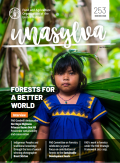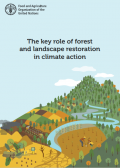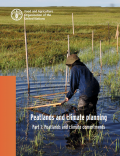Publicaciones de la FAO
Unasylva 254 - Towards more resilient and diverse planted forests (Este recurso solo está disponible en inglés)
November 2023
November 2023
This issue of Unasylva responds to the need for wider information-sharing on data, tools and approaches available for leveraging the contributions of planted forests to meet the target of increasing the global forest area of 3 percent by 2030, which Global Forest Goal 1 provides for. Unasylva issue 254 was launched in November 2023 at the International Congress on Planted Forests 2023 (ICPF2023) – the first edition of this global forum to be held in Africa (Nairobi, Kenya).
This report provides global and regional estimates of the area covered by mangrove forests, including area changes between 2000 and 2020. It analyses the drivers of these global, regional and subregional changes for the periods 2000–2010 and 2010–2020 with the aim of improving understanding of these drivers, their interactions and how their relative importance has shifted over time. In the study that underpins this report, FAO developed and validated an easy, repeatable methodology that integrates remote sensing with local knowledge. An FAO team and 48 image interpreters worldwide collected and analysed data on mangrove area in 2020, change in mangrove...
Unasylva 253 - Forests for a better world (Este recurso solo está disponible en inglés y en francés)
December 2022
December 2022
To coincide with the 50th anniversary of FAO’s Committee on Forestry, this edition of Unasylva showcases ways in which forests are delivering the "four betters" and underscores how forests are crucial for resilient and sustainable agrifood systems in a changing climate. As FAO’s longest running periodical, Unasylva focuses on issues and themes relevant to forestry and forest industries and aims to bring globally significant developments in forestry to policymakers, forest managers, technicians, researchers, students and teachers around the globe.
The key role of forest and landscape restoration in climate action (Este recurso solo está disponible en inglés)
November 2022
November 2022
This publication highlights the links between FLR and climate change mitigation and adaptation issues and considers further opportunities to enable greater integration between the two agendas. It also describes the different tools that have been developed by FAO to better measure the quantities of carbon stored and other climate benefits achieved through FLR projects.
Peatlands contain huge carbon stocks yet they cover only 3 percent of the world’s land area. Improved peatland management provides climate change mitigation and adaptation opportunities. Peatland conservation and restoration also secures ecosystem services that support adaptive capacity and resilience. This brief is part of the Global Peatlands Initiative’s work to support national governments in the process of enhancing their climate commitments, such as the nationally determined contributions as well as the long-term strategies through the inclusion of climate action on peatlands. ...





